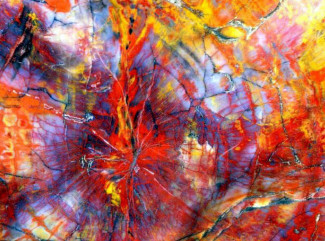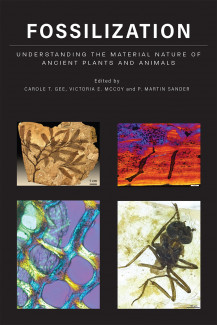
Johns Hopkins UniversityEst. 1876
America’s First Research University
Now Browsing:
The Glorious, Colorful World of Fossils

Although most people think of the fossil world in shades of drab duns, browns, and blacks, it is actually sometimes very excitingly colorful. Dinosaur eggs, for example, can shimmer blue-green, while fossil leaves can sport vivid verdant hues. In these two cases, the colors of the fossils are not a result of degradation or mineralization, but come from the preservation of biological pigments originating from once-living, now-extinct organisms. In fact, the pigments responsible for blue-green eggs and green fossil leaves derive from the same group of compounds, the porphyrins. The color of blue-green eggshells arises from the heme biosynthesis pathway, the best-known molecule of which is hemoglobin, the oxygen transporter in blood. The green color still present in some fossil leaves results from the breakdown of ancient chlorophyll, the light-absorbing pigment responsible for photosynthesis. The major difference is that the heme molecule centers around an iron atom, while the chlorophyll molecule surrounds a magnesium atom.
To me, not only is it amazing that such similar molecules that are so essential for life evolved in the wildly divergent plant and animal kingdoms, it is even more awe-inspiring that we can still find their chemical traces in organisms that lived some 42 to 67 million years ago.
The discovery, extraction, and documentation of such original biomolecules are a major focus of our book, Fossilization: Understanding the Material Nature of Ancient Plants and Animals, published by Johns Hopkins University Press in March 2021. In fact, we are searching for the limits of the fossil record—where the biological ends and the geological begins. In a nutshell, our interest centers on substance preservation in fossils, the materials found in a fossil today. This would include original biological compounds, such as the heme in dinosaur blood cells, the porphyrins in eggshells, the soft lung and brain tissues of insects embedded in amber, and the natural colors of ancient leaves and algae.

However, substance preservation also embraces the mineral compounds that make up the fossil today but which were not present in the living organism, such as those occurring in silicified wood. The spectacular colors of fossil wood from the Petrified Forest National Park in Arizona, for example, are not biological in origin, but rather, geological. Sadly, they do not come from a Triassic rainbow-colored tree, but were produced instead by post-mortem fossilization processes involving tiny amounts of iron embedded in a mass of light-colored silica. The pressing questions that we ask ourselves today all involve how.
Essential to the modern study of substance preservation and fossilization is the application of cutting-edge analytical instrumentation and methods. The revolution of the microchip has led to ever higher resolution, precision, and specialization in imaging and analysis. It is now possible to see inside ancient cells on the nanoscale level and to identify fossil compounds on the molecular level.
In Fossilization, sixteen scientists have come together to present their research on the substance preservation of fossils. We are primarily life and earth scientists—paleontologists, mineralogists, and geochemists, but also organic chemists and microbiologists. The focus of our studies is as varied as we are, ranging from dinosaur blood cells and eggshells to soft tissue in amber-encapsuled arthropods, from the rock-hard minerals making up silicified wood to the herbivore repellents and biological pigments still evident in fossil leaves. In Fossilization, we also explore the use of a huge array of high-tech instrumentation and analyses to investigate our material, especially high-resolution Raman spectrometry.
As inspirational as it is these days to seek out life on Mars, it is actually more life-affirming to me as a paleontologist to puzzle over the deep history of life on earth, to appreciate the transformation of a once-living, organic being into an inert but forever fossil, and to embrace our paleontological heritage in all of its colors and glory.
Order Fossilization: Understanding the Material Nature of Ancient Plants and Animals at the following link: https://jhupbooks.press.jhu.edu/title/fossilization
Carole T. Gee is Associate Professor of Paleontology at the University of Bonn in Germany and Research Associate at the Huntington Botanical Gardens in California. Working alongside Victoria E. McCoy and P. Martin Sander, she is the lead editor of Fossilization: Understanding the Material Nature of Ancient Plants and Animals.

To me, not only is it amazing that such similar molecules that are so essential for life evolved in the wildly divergent plant and animal kingdoms, it is even more awe-inspiring that we can still find their chemical traces in organisms that lived some 42 to 67 million years ago.
The discovery, extraction, and documentation of such original biomolecules are a major focus of our book, Fossilization: Understanding the Material Nature of Ancient Plants and Animals, published by Johns Hopkins University Press in March 2021. In fact, we are searching for the limits of the fossil record—where the biological ends and the geological begins. In a nutshell, our interest centers on substance preservation in fossils, the materials found in a fossil today. This would include original biological compounds, such as the heme in dinosaur blood cells, the porphyrins in eggshells, the soft lung and brain tissues of insects embedded in amber, and the natural colors of ancient leaves and algae.

Image: Silicified rainbow wood from Petrified Forest National Park, courtesy of Sidney R. Ash.
However, substance preservation also embraces the mineral compounds that make up the fossil today but which were not present in the living organism, such as those occurring in silicified wood. The spectacular colors of fossil wood from the Petrified Forest National Park in Arizona, for example, are not biological in origin, but rather, geological. Sadly, they do not come from a Triassic rainbow-colored tree, but were produced instead by post-mortem fossilization processes involving tiny amounts of iron embedded in a mass of light-colored silica. The pressing questions that we ask ourselves today all involve how.
Essential to the modern study of substance preservation and fossilization is the application of cutting-edge analytical instrumentation and methods. The revolution of the microchip has led to ever higher resolution, precision, and specialization in imaging and analysis. It is now possible to see inside ancient cells on the nanoscale level and to identify fossil compounds on the molecular level.
In Fossilization, sixteen scientists have come together to present their research on the substance preservation of fossils. We are primarily life and earth scientists—paleontologists, mineralogists, and geochemists, but also organic chemists and microbiologists. The focus of our studies is as varied as we are, ranging from dinosaur blood cells and eggshells to soft tissue in amber-encapsuled arthropods, from the rock-hard minerals making up silicified wood to the herbivore repellents and biological pigments still evident in fossil leaves. In Fossilization, we also explore the use of a huge array of high-tech instrumentation and analyses to investigate our material, especially high-resolution Raman spectrometry.
As inspirational as it is these days to seek out life on Mars, it is actually more life-affirming to me as a paleontologist to puzzle over the deep history of life on earth, to appreciate the transformation of a once-living, organic being into an inert but forever fossil, and to embrace our paleontological heritage in all of its colors and glory.
Order Fossilization: Understanding the Material Nature of Ancient Plants and Animals at the following link: https://jhupbooks.press.jhu.edu/title/fossilization
Carole T. Gee is Associate Professor of Paleontology at the University of Bonn in Germany and Research Associate at the Huntington Botanical Gardens in California. Working alongside Victoria E. McCoy and P. Martin Sander, she is the lead editor of Fossilization: Understanding the Material Nature of Ancient Plants and Animals.

Login to View & Leave Comments
Login to View & Leave Comments


